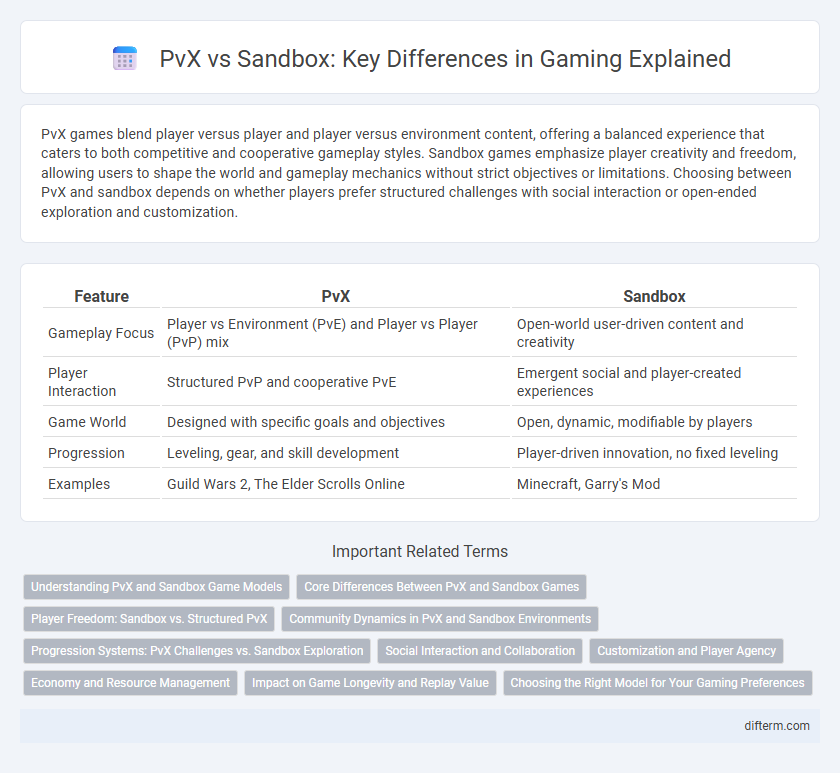PvX games blend player versus player and player versus environment content, offering a balanced experience that caters to both competitive and cooperative gameplay styles. Sandbox games emphasize player creativity and freedom, allowing users to shape the world and gameplay mechanics without strict objectives or limitations. Choosing between PvX and sandbox depends on whether players prefer structured challenges with social interaction or open-ended exploration and customization.
Table of Comparison
| Feature | PvX | Sandbox |
|---|---|---|
| Gameplay Focus | Player vs Environment (PvE) and Player vs Player (PvP) mix | Open-world user-driven content and creativity |
| Player Interaction | Structured PvP and cooperative PvE | Emergent social and player-created experiences |
| Game World | Designed with specific goals and objectives | Open, dynamic, modifiable by players |
| Progression | Leveling, gear, and skill development | Player-driven innovation, no fixed leveling |
| Examples | Guild Wars 2, The Elder Scrolls Online | Minecraft, Garry's Mod |
Understanding PvX and Sandbox Game Models
PvX and sandbox game models offer distinct player experiences; PvX combines player-versus-environment and player-versus-player elements within structured objectives, creating balanced gameplay for competitive and cooperative interactions. Sandbox games prioritize player freedom and creativity, allowing open-world exploration and user-generated content without fixed goals or linear storylines. Understanding these models helps developers design engaging environments that cater to diverse gaming preferences and promote long-term player retention.
Core Differences Between PvX and Sandbox Games
PvX games blend player versus environment (PvE) and player versus player (PvP) elements, offering structured objectives alongside competitive interactions. Sandbox games emphasize open-world exploration and player-driven creativity without fixed goals, allowing players to build, modify, and interact with the environment freely. Core differences lie in PvX's balanced conflict-driven gameplay versus sandbox's focus on emergent experiences and player autonomy.
Player Freedom: Sandbox vs. Structured PvX
Sandbox games emphasize player freedom by allowing open-ended exploration, creation, and interaction within dynamic environments that evolve based on player actions. Structured PvX (Player versus Anything) systems balance player freedom with defined objectives, combining competitive and cooperative elements through quests, missions, and rule-based progression. The contrast lies in sandbox's emergent gameplay driven by player choice versus PvX's structured content designed to guide player experiences while supporting diverse playstyles.
Community Dynamics in PvX and Sandbox Environments
PvX environments foster dynamic community interactions by balancing player-versus-player and player-versus-environment content, encouraging cooperation and competition that adapt to diverse playstyles. Sandbox games drive player creativity and emergent social structures, enabling communities to shape in-game economies, alliances, and narratives through freedom of exploration and construction. Both PvX and Sandbox support vibrant ecosystems, but PvX emphasizes structured engagement while Sandbox thrives on player-driven innovation and decentralized governance.
Progression Systems: PvX Challenges vs. Sandbox Exploration
PvX progression systems blend structured challenges like quests, raids, and PvP battles to provide clear goals and rewards that drive player advancement. Sandbox games emphasize open-ended exploration with player-driven progression through crafting, resource gathering, and territory control, allowing a personalized pacing free from rigid objectives. The difference lies in PvX's goal-oriented progression fostering competition and achievement, whereas sandbox exploration nurtures creativity and emergent gameplay without predefined endpoints.
Social Interaction and Collaboration
PvX and Sandbox games foster social interaction and collaboration through distinct mechanics; PvX blends player versus player and player versus environment elements, encouraging strategic alliances and competitive teamwork. Sandbox games emphasize open-ended creativity and player-driven content, promoting organic community building and cooperative problem-solving. Both genres leverage multiplayer environments to enhance social bonds and collaborative experiences among players.
Customization and Player Agency
PvX games offer structured content with customizable experiences tailored to both player-versus-environment and player-versus-player scenarios, enhancing engagement through predefined goals and progression systems. Sandbox games provide extensive player agency by allowing open-world exploration and unrestricted modifications, fostering creativity and personalized gameplay without rigid constraints. Customization in PvX often focuses on optimizing character builds and gear for challenges, whereas sandbox games emphasize world-building and emergent interactions driven entirely by player choices.
Economy and Resource Management
PvX games integrate player-versus-player and player-versus-environment elements, creating dynamic economies driven by competition and cooperation, where resource scarcity and market demand fluctuate based on player activities. Sandbox games emphasize player-driven economies with open-world resource management, allowing users to gather, craft, and trade materials freely, fostering emergent economic systems without pre-set limitations. Effective resource management in PvX requires balancing combat rewards and resource acquisition, while sandbox economies depend heavily on player innovation and social interactions to stabilize and grow.
Impact on Game Longevity and Replay Value
PvX games balance player-versus-player and player-versus-environment elements, resulting in diverse gameplay that sustains long-term interest and competitive engagement. Sandbox games emphasize player creativity and freedom, fostering high replay value through emergent gameplay and user-generated content. The combination of structured challenges in PvX and open-ended innovation in sandbox environments significantly enhances overall game longevity.
Choosing the Right Model for Your Gaming Preferences
PvX gaming blends player-versus-environment and player-versus-player elements, offering dynamic content for diverse playstyles and fostering competitive yet cooperative experiences. Sandbox games emphasize open-world exploration and creativity, empowering players with freedom to shape narratives and environments without strict objectives. Choosing the right model depends on whether you prefer structured challenges and social interaction in PvX or unrestricted creativity and self-directed gameplay in sandbox environments.
PvX vs Sandbox Infographic

 difterm.com
difterm.com